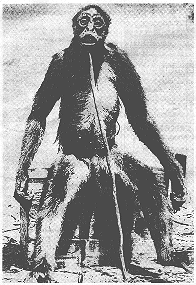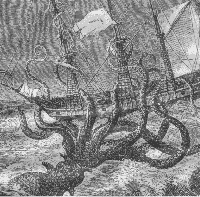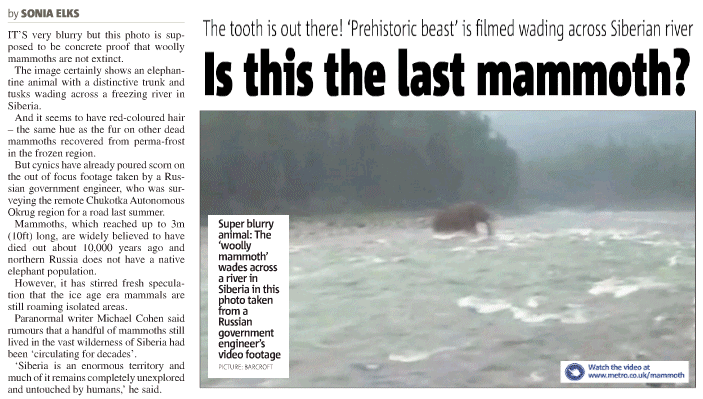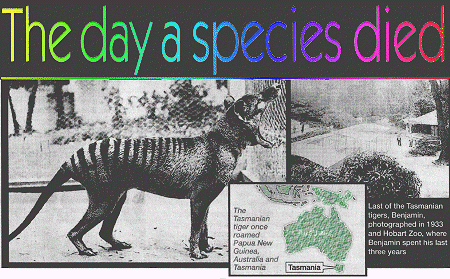Monkeying around with mystery tales
 |
A weekly appreciation of nature.
 |
PICTURE the scene: It is 1920 and you find yourself in the
dense forests along the Venezuela-Columbia border.
The rain is battering heavily on the lofty canopy 100 feet above and the
distant call of a howler monkey distracts you momentarily from your work
as a geologist.
Unknown to you, there are a couple of watchers in the woods, and they are
just about to approach you in a menacing fashion.
CRASH through the undergrowth they come, the 8ft male to the fore, with his
partner at his side. What do you do? Shoot them of course Well, that is what
Swiss geologist Francois de Loys did when the above scenario actually happened
81 years ago.
De Loys and his party were, to say the least, a little shocked. The anthropoid
apes were new to science and have not been seen since.
The corpse pictured here is in fact the female - the geologists have quickly
propped her up on a packing case to take a photograph.
When their expedition was completed, de Loy circulated the pictures to both
scientists and the press to a mixed reaction.
Some heralded the discovery of a new species and it was named Ameranthropoldes
loysi, because of its remarkable human lineaments,
while others claimed it was nothing more than an overgrown spider monkey.
In the ensuing years the photograph has been subjected to as much examination
as the Turin Shroud and the jury is still out.
By now, some readers will be thinking this sounds a bit like that famous
picture of the Loch Ness Monster. And that is exactly what it is, a
puzzle, a mystery, a possibility. Does the Tasmanian
tiger still exist or did Yorkshireman Wilf Batty kill the last one in 1936?
Did Sir Peter Scott realise that his scientific name for Nessie, Nessiteras
Rhombopteryx, was an anagram of 'monster hoax by Sir Peter S'?
And is the wonderful cine film of Bigfoot running through a forest clearing
in North America nothing more than an elaborate prank by a man in fancy dress?
Would readers like to know the answer? I certainly would and I have to admit
that I have been fascinated by the subject of cryptozoology - the study of
'hidden' animals - ever since I attended the annual conference of the
International Society of Cryptozoology in 1987.
The society's leading light and first president, Bernard Heuvelmans, has
just died at the age of 84. He combined boyish enthusiasm with scienfific
thoroughness and right up to his death he continued to travel the globe looking
for evidence of cyrptid species.
These induded the giant sloth, the infamous yeti, the terrifying kracken
and that old favourite, the sea serpent. Heuvelmans and his ilk completely
ignored the cynics and were able to cite an assortment of precedents to back
up their claims. The okapi was only discovered in 1901, the giant
Komodo dragon was believed to be nothing more than native suspicion
until a western traveller spotted one in 1912, and then there is my personal
favourite, the deep sea ceolacanth.
This prehistoric deep sea fish was pulled from a shark net off the coast
of western Africa in 1938. Previously it was only known from fossils and
thought to have become extinct millions of years earlier.
Things that go "bloop in the dark sea
ANY READERS planning on swimming in the sea this summer please
look away now.
Either that or ensure you carry some kind of electric marine cattle prod
to ward off things from the deep!
To be more precise, things that go 'bloop' in the night have attracted the
interest of marine biologists and crypto-zoologists from across the globe,
ever since the mysterious sound was picked up by sensors originally put in
place to monitor the movement of Soviet submarines.
The frequency of the acoustic signal resembles known marine animal-calls,
it is however, much louder. So noisy is this unknown creature, that the calls
have been detected by sensors three thousand miles apart. Even the largest
whales cannot shout that loud.

Squid
There have been suggestions that a giant squid, like the one pictured here
in an engraving by Edward Etherington in 1887, is responsible.
These almost mythical animals are believed to survive depths of up to three
miles, but none have been caught alive. The largest dead squid measured 60ft,
including the length of its tentacles, but it is almost certain that they
can grow much bigger.
Some researchers think that the squid is unlikely to make a 'bloop' sound,
but even then they qualify their comment with a 'you never know' rider.
Phil Lobel, a marine biologist at Boston University, said in
New Scientist magazine:
"Cephalopods have no gas-filled sac, so they have
no way to make that type of noise. though you can never rule anything of
it completely."
The signals, which were first picked up in 1997, have been recorded by listening
stations hundreds of metres below the ocean surface. At this depth the sound
waves become trapped in a layer of water known as the 'deep sound channel',
a phenomenon where a combination of pressure and temperature combine to allow
sound waves to keep on travelling.
The majority of the sounds detected have been identified as coming from whales,
ships or earthquakes, but the 'bloop' has them all guessing.
It is refreshing to know that man has not conquered the denizens of the deep,
and I am sure that there are still a great number of undiscovered creatures
both in the oceans and on land waiting to be discovered.
Could the 'bloop' emanate from the fabled Kracken, the giant many-tentacled
sea monster which gave many a Jack Tar nightmares? I'd like to think so,
and woe betide any cynic who might deride this notion, because it is not
a safe bet these days to say never.
Perhaps the most famous discovery in the past hundred years to confound the
experts, was the ceolacanth, a large deep sea fish thought extinct
for millions of years, until one was caught in a fishing net near the Comoros
Islands in 1938.
And even in the late 20th century, mammals were being discovered on a regular
basis, including a couple of large ungulates in the dense forests of Vietnam,
a tree climbing marsupial in Australia and new species of dolphin in the
Indian Ocean.
My guess is that we will keep discovering new species and I have to confess
to being intrigued by mysteries like the 'bloop', and I never tire of the
ongoing saga of the Yeti, Bigfoot and Nessie.
What do you think, is a monster to blame for the 'bloop'?
Or do you believe all these stories to be merely fanciful nonsense?
|
||
| On this day in 1936, in a tiny zoo located in a peaceful coiner of Tasmania,
unfolded a quiet tragedy. Benjamin, the last of his kind, lay dying. Three
years earlier, in the Tasmanian woods he called horne, trappers had come
and the life he had known came to an end and his slow, lonely death had begun.
1936 had been a strange year for weather in Tasmania, long days of searing
hot sun were followed by longer nights of freezing darkness and, through
it all, Benjamin had suffered. Caged in a tiny chicken-wire enclosure, he
seemed to have been forgotten by keepers at the Hobart Zoo. The small wooden
box that served as his sleeping quarters was locked for days, leaving him
with no retreat from the elements, and he was left little water to quench
his thirst. The night of September 6, 1936, was colder than most and, by
morning, with no keepers to care for him and nowhere to shelter from the
cold, Benjamin, the last of the Tasmanian tigers, died and his species passed
into extinction. Thylacinus cynocephulus, nicknamed the Tasmanian tiger,
was the last surviving member of a family of marsupial predators thylacines
- which had lived in Australia and Tasmania for millions of years until the
arrival of humans. Man's arrival on the Australian continent 4,000years ago
- and the dogs (dingos) he brought with him - pushed the tiger from the mainland
until, 2,000 years later, the island of Tasmania became its last refuge.
Without competition from dingos, Tasmanian tigers - whose name came from
the dark stripes found on its back, rump and tail - lived on a diet of kangaroo,
wombat, possum and birds. Then, in 1803, livestock farming white settlers
arrived on the island and added sheep to the tiger's menu. It didn't take
long before the tiger became public enemy No.1. In 1830, the first bounty
was offered by the Van Diemens Land Company and, by 1888, the Tasmanian
government as offering a prize of £1 for every dead 'tiger'. The unfortunate
creature also fell foul of a propaganda campaign designed to stir up public
hatred by painting the Tasmanian tiger as voracious livestock killer. During
one such campaign photographs were distributed claiming to show one in the
act of slaughtering chickens - in reality it was a posed shot of a stuffed
tiger. The tactics worked and,between 1876 and 1896 more than 3,400 tigers
were turne din for the reward and made into waistcoats. It didn't take long
for numbers to dwindle. In 1902 only 119 bounties were claimed and by 1909
the number tracked down by hunters had dropped to two. In 1901, when it started
to become apparent the tiger was in trouble - or, more importantly, the supply
of specimens available for sale to private collections was in trouble a
conservation campaign was launched. Benjamin was the last Tasmania 1933,
he was sold d to the Hohart Zoo - where the last film footage of the animal
was taken. On July 10, 1936, the Tasmanian tiger was granted official protection
by the Tasmanian government - 59 days later Benjainin, last of the Tasmanian
tigers, was dead. As a final insult to the beast - and an indication of how
little regard was paid to it, Benjamin was never properly sexed and it -
is now thought that he may have been a she. September 7 is now National
Threatened Species Day in Australia.
[Metro Sep7,2007]
|

Links RSPCA | IFAW | Animal Planet | MAFF | Badger | Bear | Fox | Castle | Magpie | Cryptozoology |Quagga Project |

 The Tasmanian tiger, or thylacine, was the largest known carniverous marsupial
of modern times
The Tasmanian tiger, or thylacine, was the largest known carniverous marsupial
of modern times